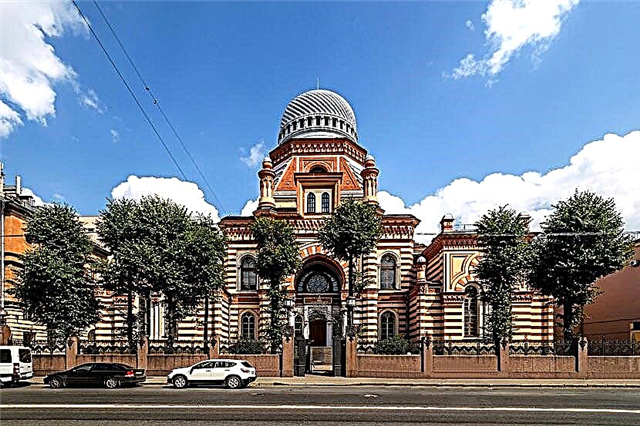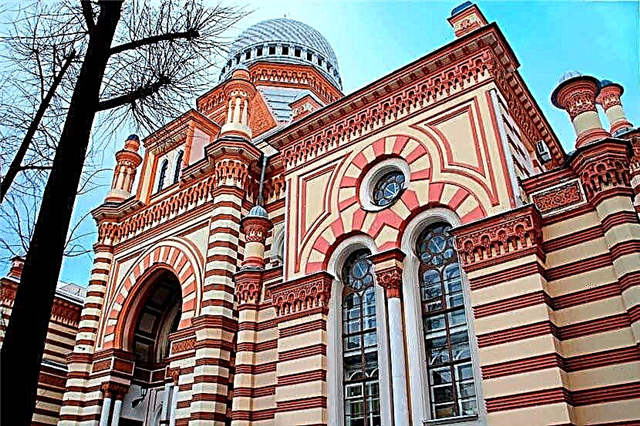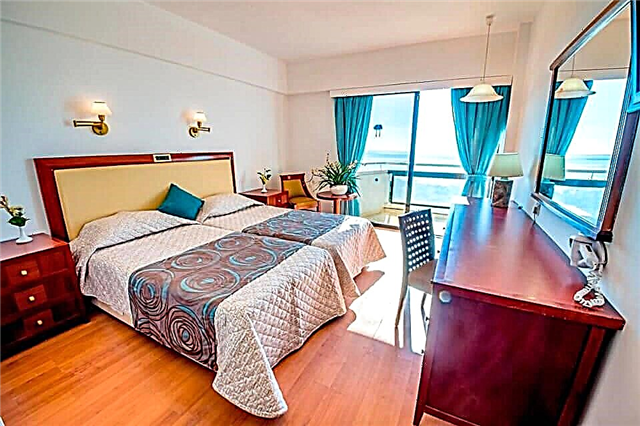Address: Russia, St. Petersburg, Lermontovsky proezd, 2
Building: 1883 - 1893 years
Architects: L. I. Bakhman, I. Shaposhnikov with the participation of V. V. Stasov and N. L. Benois
Coordinates: 59 ° 55'28.8 "N 30 ° 17'30.3" E
Federal cultural heritage site of the peoples of the Russian Federation
Content:
Among the cathedrals and temples of St. Petersburg there are many magnificent architectural monuments. Between the Moika River and the Griboyedov Canal, in the historical center of the northern capital, there rises an amazingly beautiful neo-Moorish building. The unusual St. Petersburg synagogue was built at the end of the 19th century and became a spiritual center for all Jews who lived in the former capital of Russia.

General view of the synagogue
Synagogue history
The Jewish community in the city emerged at the end of the 18th century. According to a census conducted in the 1820s, there were 370 Jews in St. Petersburg, but they were not Jews.
Since 1791, the Pale of Settlement was legalized in the Russian Empire, according to which the Jews were forced to settle only in certain places. Only Jews who renounced their original faith and converted to Orthodoxy were allowed to come to St. Petersburg. Relief came under Alexander II, and by the 1880s the city community had grown to 16.5 thousand people.
The Jews of St. Petersburg had several small chapels and dreamed of a large synagogue for many years. The money for the construction of the prayer house was allocated by one of the richest people of the Russian Empire, Baron Horace Osipovich Gintsburg and a wealthy businessman Solomon Lazarevich Polyakov.

View of the synagogue from Lermontovsky passage
In 1880, architects Lev Isaakovich Bakhman and Ivan Ivanovich Shaposhnikov developed a project for a new prayer house. On the advice of the music and art critic Vladimir Vasilyevich Stasov, they gave the building colorful Arab-Moorish features. Professor of architecture Nikolai Leontievich Benois took part in the development of the original project. Construction began in 1883 and ended 10 years later.
After the synagogue received the believers, all prayer places in the city were closed. The Jews who lived in St. Petersburg had difficulties. The new building, although large, could not accommodate everyone. Only in 1904 was it allowed to open new chapels for Jews in the city.
In the 1930s, an active campaign against religion was launched in the USSR; the Leningrad City Executive Committee closed the synagogue. Members of the Jewish community were outraged by this decision, wrote a letter of protest, and the All-Russian Central Executive Committee returned the synagogue to the parishioners. The city authorities did not give up. Several times they offered to transfer the synagogue to the House of Political Education or the Theater of Young Spectators, but, fortunately, this did not happen.

During the blockade, tens of thousands of Leningraders died in the city. In the harsh winter of 1941-1942, the dead Jews began to be brought to the synagogue, therefore, from the gate to the entrance to the temple, whole piles of dead bodies grew. In the spring, when the ground thawed, the corpses were buried.
After the war, believers experienced another persecution. The synagogue was not allowed to bake matzo, and Jews were forbidden to be buried in the Jewish cemetery.
Before the 1980 Olympics, the ancient temple was included in the list of tourist sites in Leningrad, so the building was overhauled. In 2013, parishioners celebrated the 120th anniversary of their prayer house.
Architectural features and interiors
The St. Petersburg church has the status of an architectural monument of federal significance. Today it is the largest synagogue in our country and the second largest Jewish temple in Europe. It is second only to the synagogue, which is located in the center of the Jewish quarter of the capital of Hungary - the city of Budapest.

The unique acoustics of the prayer house are well known. Face the wall at one end of the lobby and ask people you know to whisper something from the other end of the lobby. Despite the fact that you are 10 meters away, all the words will be heard well. Paradoxically, in the center of the building, the sound of the voice is noticeably amplified.
The interiors of the synagogue are impressive! The rooms are illuminated by beautiful chandeliers, and the walls are covered with colorful paintings.
Old wooden benches have been preserved inside. It is noteworthy that they survived the difficult days of the Leningrad blockade. The inhabitants of the city suffered from hunger and cold, letting everything they could for firewood. Despite the hardest times, no one dared to touch the pews from the house of worship!
Small synagogue
The Big Synagogue is adjacent to one of the historical churches of St. Petersburg - the Small Synagogue. At the end of the 19th century, this building housed the Merchant prayer house of the St. Petersburg Hasidim, and today Orthodox Jews gather.

In 2011-2015, the Small Synagogue was overhauled. When opening the old floors, workers found several amazing artifacts - packaging from pre-revolutionary candles, an old spoon, a knife, a bottle, a glass monocle, a 1930s tram ticket and scraps of 70-year-old Leningrad newspapers.
The specialists have done a great job and restored the parquet floor from precious wood, colored patterned ceilings, openwork windows and wooden doors. Today, tourists can see the interiors of the Small Synagogue the same as when the house of prayer was opened in October 1886.
Temple today
The St. Petersburg synagogue is the main spiritual center of the city's Jewish community, which today numbers more than 35 thousand people. People come here not only to pray. In the synagogue, holidays are celebrated, contracts are made, weddings are held, lectures are given and money is collected to help those in need.

A large library "Sifriya" was opened at the temple, in the funds of which there are more than 3500 volumes. Everyone is enrolled in the library, regardless of religion and nationality. Everyone who is interested in publications on philosophy, modern literature of Israel, the study of Hebrew, national traditions, history and culture of the Jewish people comes here.
The temple finds funds for the maintenance of two kindergartens, two schools and two boarding schools, which are attended by about five hundred children of different ages. Jewish youths attend yeshiva and receive religious education.
Every year the synagogue hosts Open Doors Days. Residents of the city and tourists love the concerts of Jewish music, master classes and educational programs for children and adults. Guests are told about Jewish rituals, traditions of Jewish weddings and seeing off the deceased.
Very interesting are the lectures of the soifer - a scribe with a demonstration of Jewish ritual scrolls: a marriage contract or a ktuba, Torah, mezuzah and tefillin. Visitors are offered half-hour tours of the building.

The entrance to the Synagogue's Open Day is free, a ticket to the concert costs 100 rubles. It is noteworthy that all tickets are sold out in advance, and there are never empty seats in the hall.
Useful information for tourists
The synagogue opens at 10:00. From Monday to Thursday, it can be accessed until 18:00, on Friday - until 16:00, and on Sundays from 11:00 to 19:00. On Saturdays, the building is closed on Shabbat.
Everyone is allowed inside the temple. You can take photos and videos without restrictions. Tourists are asked to dress neatly and modestly, not to disturb the parishioners, the rabbi and the cantor, and not to make noise.
According to Jewish law, married women are allowed to be in synagogue only with their heads covered and wearing clothes that cover their elbows and knees. Men must wear a kippah or other headgear.

The synagogue has a Kosher shop that sells kosher foods, drinks, souvenirs, books, religious items, jewelry, household chemicals from Israel and Dead Sea cosmetics.
For a bite to eat, head to the cozy Lechaim restaurant. Kosher is open Monday through Thursday from 10:00 to 22:00, on Fridays from 10:00 to 17:00, and on Sunday from 10:00 to 22:00.Guests are treated to traditional Ashkenazi Jewish cuisine - stuffed fish, forshmak, strudel, tsimes, harira soup and quiche with chicken and mushrooms.
Tourists who have come to St. Petersburg can stay overnight at the Malon guest house at the synagogue. Guests live in 2-4-bed rooms with all conveniences and enjoy discounts when ordering food at the Lechaim restaurant and individual city tours.

How to get there
The synagogue is located at Lermontovsky proezd, 2. It is easy to walk to the temple in 25 minutes from the Sadovaya, Spasskaya and Sennaya Ploshchad metro stations. Nearby, on Dekabristov Street, there are city buses and minibuses. You need to get off at the stop "Lermontovsky proezd" or "Mariinsky theater".











